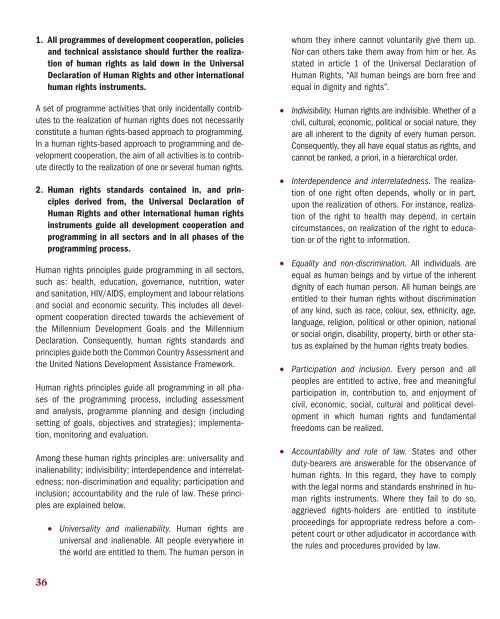Frequently Asked Questions on Human Rights-Based Approach
Frequently Asked Questions on Human Rights-Based Approach
Frequently Asked Questions on Human Rights-Based Approach
- No tags were found...
You also want an ePaper? Increase the reach of your titles
YUMPU automatically turns print PDFs into web optimized ePapers that Google loves.
1. All programmes of development cooperati<strong>on</strong>, policiesand technical assistance should further the realizati<strong>on</strong>of human rights as laid down in the UniversalDeclarati<strong>on</strong> of <strong>Human</strong> <strong>Rights</strong> and other internati<strong>on</strong>alhuman rights instruments.A set of programme activities that <strong>on</strong>ly incidentally c<strong>on</strong>tributesto the realizati<strong>on</strong> of human rights does not necessarilyc<strong>on</strong>stitute a human rights-based approach to programming.In a human rights-based approach to programming and developmentcooperati<strong>on</strong>, the aim of all activities is to c<strong>on</strong>tributedirectly to the realizati<strong>on</strong> of <strong>on</strong>e or several human rights.2. <strong>Human</strong> rights standards c<strong>on</strong>tained in, and principlesderived from, the Universal Declarati<strong>on</strong> of<strong>Human</strong> <strong>Rights</strong> and other internati<strong>on</strong>al human rightsinstruments guide all development cooperati<strong>on</strong> andprogramming in all sectors and in all phases of theprogramming process.<strong>Human</strong> rights principles guide programming in all sectors,such as: health, educati<strong>on</strong>, governance, nutriti<strong>on</strong>, waterand sanitati<strong>on</strong>, HIV/AIDS, employment and labour relati<strong>on</strong>sand social and ec<strong>on</strong>omic security. This includes all developmentcooperati<strong>on</strong> directed towards the achievement ofthe Millennium Development Goals and the MillenniumDeclarati<strong>on</strong>. C<strong>on</strong>sequently, human rights standards andprinciples guide both the Comm<strong>on</strong> Country Assessment andthe United Nati<strong>on</strong>s Development Assistance Framework.<strong>Human</strong> rights principles guide all programming in all phasesof the programming process, including assessmentand analysis, programme planning and design (includingsetting of goals, objectives and strategies); implementati<strong>on</strong>,m<strong>on</strong>itoring and evaluati<strong>on</strong>.Am<strong>on</strong>g these human rights principles are: universality andinalienability; indivisibility; interdependence and interrelatedness;n<strong>on</strong>-discriminati<strong>on</strong> and equality; participati<strong>on</strong> andinclusi<strong>on</strong>; accountability and the rule of law. These principlesare explained below.Universality and inalienability. <strong>Human</strong> rights areuniversal and inalienable. All people everywhere inthe world are entitled to them. The human pers<strong>on</strong> inwhom they inhere cannot voluntarily give them up.Nor can others take them away from him or her. Asstated in article 1 of the Universal Declarati<strong>on</strong> of<strong>Human</strong> <strong>Rights</strong>, “All human beings are born free andequal in dignity and rights”.Indivisibility. <strong>Human</strong> rights are indivisible. Whether of acivil, cultural, ec<strong>on</strong>omic, political or social nature, theyare all inherent to the dignity of every human pers<strong>on</strong>.C<strong>on</strong>sequently, they all have equal status as rights, andcannot be ranked, a priori, in a hierarchical order.Interdependence and interrelatedness. The realizati<strong>on</strong>of <strong>on</strong>e right often depends, wholly or in part,up<strong>on</strong> the realizati<strong>on</strong> of others. For instance, realizati<strong>on</strong>of the right to health may depend, in certaincircumstances, <strong>on</strong> realizati<strong>on</strong> of the right to educati<strong>on</strong>or of the right to informati<strong>on</strong>.Equality and n<strong>on</strong>-discriminati<strong>on</strong>. All individuals areequal as human beings and by virtue of the inherentdignity of each human pers<strong>on</strong>. All human beings areentitled to their human rights without discriminati<strong>on</strong>of any kind, such as race, colour, sex, ethnicity, age,language, religi<strong>on</strong>, political or other opini<strong>on</strong>, nati<strong>on</strong>alor social origin, disability, property, birth or other statusas explained by the human rights treaty bodies.Participati<strong>on</strong> and inclusi<strong>on</strong>. Every pers<strong>on</strong> and allpeoples are entitled to active, free and meaningfulparticipati<strong>on</strong> in, c<strong>on</strong>tributi<strong>on</strong> to, and enjoyment ofcivil, ec<strong>on</strong>omic, social, cultural and political developmentin which human rights and fundamentalfreedoms can be realized.Accountability and rule of law. States and otherduty-bearers are answerable for the observance ofhuman rights. In this regard, they have to complywith the legal norms and standards enshrined in humanrights instruments. Where they fail to do so,aggrieved rights-holders are entitled to instituteproceedings for appropriate redress before a competentcourt or other adjudicator in accordance withthe rules and procedures provided by law.36
















